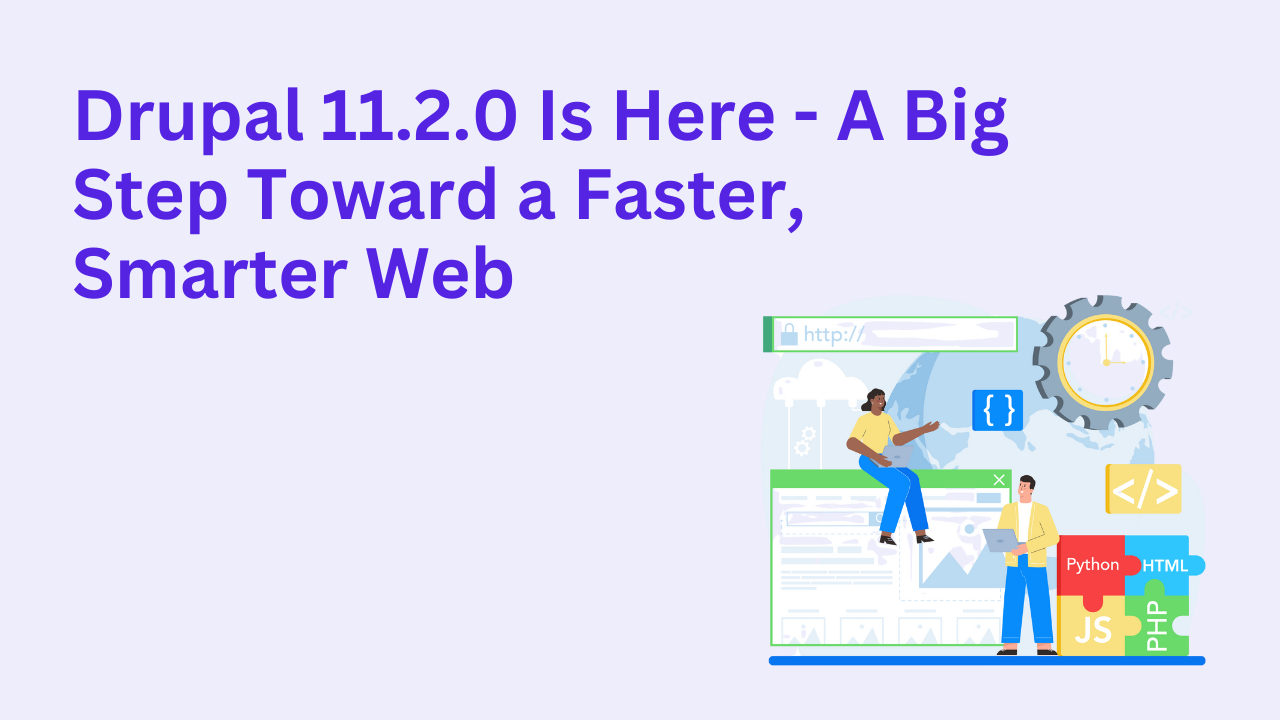How to Migrate from Drupal 10 to Drupal 11

Migrating from Drupal 10 to Drupal 11 is a crucial step for maintaining the performance, security, and functionality of your website. With the release of Drupal 11, users can benefit from enhanced features, improved performance, and long-term support, ensuring their sites remain competitive in the ever-evolving digital landscape.
This guide provides an in-depth walkthrough of the migration process, tailored to help developers, site administrators, and businesses achieve a seamless upgrade. Let’s dive into the details and make your transition to Drupal 11 smooth and efficient.
Why Upgrade to Drupal 11?
Enhanced Features and Performance
Drupal 11 introduces several game-changing enhancements designed to optimize the user experience and developer workflow. Key highlights include:
- Streamlined Layout Builder: A more intuitive interface for building and managing layouts.
- Advanced Media Library: Improved media handling tools to manage digital assets efficiently.
- Modern API Integrations: Enhanced API capabilities for headless Drupal setups.
These features make Drupal 11 an attractive choice for websites seeking top-notch performance and user engagement.
Security and Compliance
Security is paramount for any website. With Drupal 10 eventually reaching end-of-life, staying on an unsupported version could expose your site to vulnerabilities. Drupal 11 offers:
- Regular security updates
- Compliance with the latest web standards (e.g., PHP 8.1 compatibility)
- Enhanced protection against emerging threats
Future-Proof Your Website
Drupal 11 positions your website to take advantage of future technological advancements. By upgrading now, you avoid technical debt and ensure better compatibility with new modules, integrations, and APIs.
Improved Editorial Experience
One of Drupal 11’s standout features is its focus on improving the editorial experience. Content creators benefit from:
- Enhanced drag-and-drop functionality in Layout Builder.
- A more intuitive WYSIWYG editor.
- Improved workflows for managing content revisions.
This makes Drupal 11 a more user-friendly platform for non-technical users.
Overview of the Drupal 10 to Drupal 11 Migration Process
Migrating from Drupal 10 to Drupal 11 involves three major phases:
- Preparation: Conduct a thorough audit of your existing site to identify potential issues.
- Execution: Update the core software, contributed modules, and themes while addressing compatibility issues.
- Validation: Test the updated site extensively to ensure functionality and performance.
Key Benefits of Following a Structured Migration Process
A well-planned migration process ensures:
- Minimal downtime for your website.
- Reduced risk of data loss.
- Compatibility with future updates and features.
Preparing for the Migration
Steps to Take Before Starting Your Migration Journey
Thorough preparation is essential for a successful migration. Here’s how to get started:
- Audit Your Current Site: Identify critical modules, custom code, and configurations. Use tools like Drupal’s Upgrade Status module to check compatibility.
- Create Backups: Back up your database, configuration files, and uploaded assets. Consider using tools like Backup and Migrate for a smooth process.
- Evaluate Hosting Environment: Ensure your hosting environment supports the requirements for Drupal 11 (e.g., PHP 8.1, MySQL 8.0, and updated server software).
System Requirements for Drupal 11
Running Drupal 11 effectively requires meeting the following technical prerequisites:
- PHP: Version 8.1 or later
- Database: MySQL 8.0, MariaDB 10.4+, or equivalent
- Web Server: Apache 2.4.7+, Nginx, or similar
- Composer: Latest version for managing dependencies
Confirm that your hosting provider meets these standards before proceeding.
Assessing Your Current Drupal 10 Setup
Conduct a comprehensive review of your Drupal 10 site:
- Modules: Identify deprecated or unsupported modules and find alternatives. Tools like Upgrade Status can help.
- Themes: Check if your custom or contributed themes are compatible with Drupal 11.
- Custom Code: Audit custom modules and ensure they align with the latest API standards. Use tools like Drupal Check to analyze code.
Tools for Pre-Migration Analysis
Several tools can streamline the pre-migration process:
- Upgrade Status Module: Evaluates module and theme compatibility.
- Drush Commands: For exporting configurations and running checks.
- Rector: Assists in automating the refactoring of deprecated code.
Understanding the Migration Process
How the Drupal Migration Process Works
Drupal’s upgrade path focuses on maintaining continuity while ensuring compatibility with new features. The process typically involves:
- Composer Updates: Updating core files and dependencies using Composer.
- Module Compatibility Checks: Reviewing and updating all installed modules.
- Database Updates: Running database migrations to align with Drupal 11’s schema.
- Theme Adjustments: Ensuring your site’s theme supports the new version.
Drupal 10 to Drupal 11 Migration Checklist
- Backup your site.
- Verify compatibility using Upgrade Status.
- Update core files and modules via Composer.
- Test thoroughly in a staging environment.
- Deploy the migration to the live site.
Key Differences Between Drupal 10 and Drupal 11
While Drupal 11 builds upon Drupal 10, it introduces several important changes:
- API Updates: New and improved APIs for developers.
- Enhanced User Experience: Improvements to editorial tools and workflows.
- Deprecated Features: Removal of outdated functionalities to streamline performance.
Executing the Migration
Step-by-Step Guide to Migrating from Drupal 10 to Drupal 11
Follow these steps for a successful migration:
Step 1: Backup Your Site
Ensure you have a full backup of your site’s database, files, and configuration. This step protects your data in case of unexpected issues.
Step 2: Update Composer
Run the following command to ensure Composer is updated:
composer self-update
Step 3: Update Core Files
Upgrade Drupal core by running:
composer require drupal/core:~11.0
Step 4: Check Modules and Themes
Identify outdated or unsupported modules using Upgrade Status and update them:
composer require drupal/module_name
Step 5: Run Database Updates
Execute the following command to apply schema changes:
drush updb
Step 6: Test and Validate
Perform extensive testing in a staging environment. Check:
- Forms and functionality
- User permissions
- Mobile responsiveness
Updating Core and Contributed Modules
Contributed modules play a critical role in your Drupal site. Use Composer to update these modules while ensuring compatibility with Drupal 11.
composer requires drupal/contributed_module_name.
For unsupported modules, find replacements or consider custom development.
Testing and Fixing Deprecated Code
Use tools like Drupal Check and Rector to identify and fix deprecated code.
drupal-check ./
Refactor custom code to adhere to Drupal 11’s API standards.
Ensuring Theme Compatibility
If you use a custom theme, update its templates and preprocess functions to align with Drupal 11’s changes. Consider using the Olivero theme as a fallback during the transition.
Post-Migration Considerations
Validating the Migration: Key Testing Practices
- Functionality Testing: Validate forms, navigation, and dynamic content.
- Performance Testing: Use tools like Lighthouse to benchmark site speed.
- Security Testing: Scan for vulnerabilities using OWASP ZAP.
How to Monitor for Errors After Migration
Monitor logs and error reports in real time using:
- Drupal’s built-in logging system
- Third-party tools like New Relic
Optimizing Site Performance in Drupal 11
To maximize site performance:
- Enable caching for pages and blocks.
- Use a Content Delivery Network (CDN) for faster content delivery.
- Optimize image formats with WebP.
Maintaining Security After Migration
- Regularly update core, modules, and themes.
- Implement 2FA for administrative accounts.
- Use security modules like Paranoia.
Best Practices and Tips
Common Pitfalls During Drupal Migrations and How to Avoid Them
- Neglecting Backups: Always create backups before proceeding.
- Ignoring Deprecated Modules: Replace outdated modules with compatible alternatives.
- Rushing Testing: Thorough testing is essential to avoid post-deployment issues.
Tips for Managing Large-Scale Drupal Sites During Migration
- Break the migration into manageable phases.
- Use version control systems like Git to track changes.
- Assign clear roles and responsibilities to team members.
Using Automation Tools to Simplify the Migration Process
- Drush: For command-line management
- Acquia BLT: For automation and deployment
- Rector: For automated code refactoring
Case Studies and Real-World Examples
Case Study: Successful Migration from Drupal 10 to Drupal 11
An educational institution migrated to Drupal 11 and achieved:
- 40% faster page load speeds
- Improved mobile accessibility
- Easier content management for editors
Lessons Learned from Failed Drupal Migrations
- Allocate sufficient time for compatibility checks.
- Avoid skipping the staging environment.
- Document every custom code change for future reference.
FAQs and Resources
Frequently Asked Questions About Drupal 11 Migration
Q: How long does it take to migrate from Drupal 10 to Drupal 11?
A: Depending on site complexity, it can take anywhere from a few days to several weeks.
Q: Is professional assistance necessary for migration?
A: For complex sites, hiring experienced developers is highly recommended.
Q: Can I roll back if something goes wrong?
A: Yes, if you have a reliable backup system in place.
Top Resources and Tutorials for Drupal Migrations
Additional Training Resources
- Drupalize.Me for in-depth tutorials.
- Webinars from leading Drupal agencies.
- Community forums for real-time advice and support.
Conclusion
Final Thoughts: Preparing for the Future with Drupal 11
Migrating to Drupal 11 ensures your site remains secure, fast, and user-friendly. With proper planning and execution, this upgrade can unlock new opportunities for growth and innovation.
Drupal’s Roadmap: What to Expect Beyond Drupal 11
Future versions of Drupal aim to simplify user interfaces, enhance accessibility, and integrate cutting-edge technologies like AI and machine learning. Staying updated will keep your site at the forefront of digital innovation.
Ready to start your migration? Begin by contacting Drupalify and we will start with auditing your current site and can help you with drupal 10 to drupal 11 migration!








